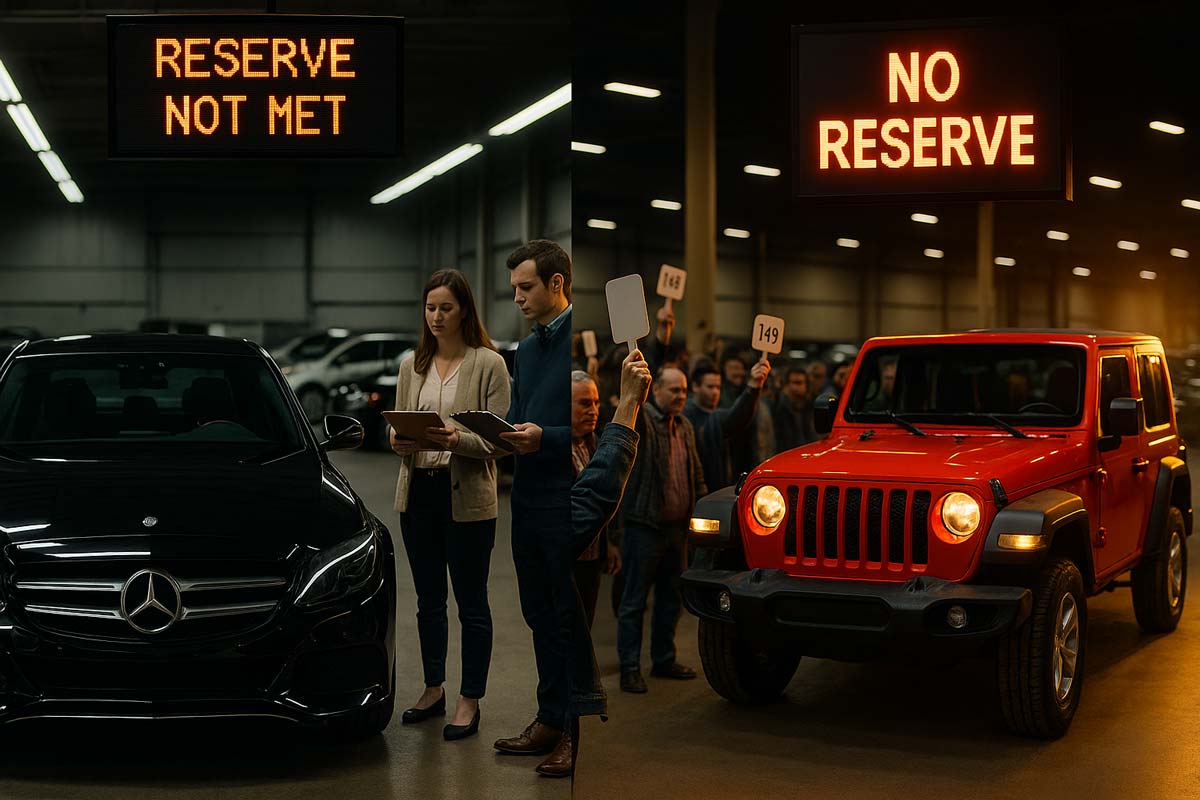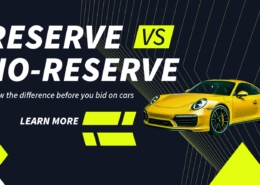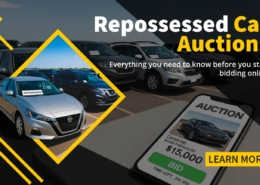 https://auction.ridesafely.com/images/2025/09/flip-cars-for-profit-auction-guide-banner.jpg
865
1440
RideSafely
/images/2025/01/ridesafely-logo.svg
RideSafely2025-09-12 13:10:342025-09-12 16:19:52Flip Cars for Profit: Your Beginner’s Auction Game Plan
https://auction.ridesafely.com/images/2025/09/flip-cars-for-profit-auction-guide-banner.jpg
865
1440
RideSafely
/images/2025/01/ridesafely-logo.svg
RideSafely2025-09-12 13:10:342025-09-12 16:19:52Flip Cars for Profit: Your Beginner’s Auction Game PlanWhen participating in vehicle auctions, it is essential to understand the differences between reserve and no-reserve auctions. At RideSafely, we believe informed buyers make confident bids—and confident bids win. This comprehensive guide examines the workings of reserve and no-reserve auctions, their strategic advantages, and how to optimize your success regardless of the auction format. For a look at the wide variety of cars available, explore our diverse range of vehicles across all categories.
What Is a Reserve Auction?
A reserve auction sets a minimum price—known as the reserve price—that must be met before the seller is obligated to complete the sale.
Key Characteristics of Reserve Auctions
- Seller Control: The vehicle will not sell unless the reserve price is met.
- Hidden Threshold: Buyers are not always told the reserve price.
- Flexible Bidding: Bidding can start low, but the reserve must be hit to sell.
- Seller Safety Net: Protects the seller from selling below market value.
Use Cases for Reserve Auctions
- Rare or exotic vehicles
- High-value salvage or classic cars
- Auctions where sellers want pricing control
What Is a No-Reserve Auction?
In a no-reserve auction (also called an absolute auction), the highest bidder wins—regardless of the final price.
Key Characteristics of No-Reserve Auctions
- Guaranteed Sale: The car will sell to the highest bidder.
- More Competitive: Attracts more bidders due to the possibility of scoring a deal.
- Fast Turnover: Popular among sellers who need quick liquidation.
Many of these sales take place in bank and repo auctions, where inventory must move quickly, creating real opportunities for bargain hunters.
Ideal For:
- Fleet liquidations or surplus inventory
- Repossessed or insurer-owned salvage vehicles
- Situations where the market determines value
Reserve vs. No-Reserve: Full Comparison Table
| Feature | Reserve Auction | No-Reserve Auction |
|---|---|---|
| Minimum Price Set? | Yes (hidden or visible) | No |
| Seller Can Decline Sale? | Yes (if reserve not met) | No (sale is final at highest bid) |
| Attracts More Bidders? | Less often (buyers unsure of outcome) | Yes (higher transparency) |
| Risk to Seller | Low | Higher risk of underselling |
| Buyer Opportunity | Limited by reserve | Strong chance for bargains |
| Used for High-Value Cars? | Frequently | Rarely |
| Bid Excitement Level | Moderate | High |
How Sellers Set Reserve Prices
Setting the proper reserve is a balancing act. It’s typically based on:
- Market research and comparable sales
- Appraisals or auction estimates
- Seller’s financial needs
- Condition and uniqueness of the vehicle
Winning Strategies for Bidders in Each Auction Type
In Reserve Auctions
- Bid Early to Test the Reserve: Early low bids can help determine if the reserve is set too high or too low.
- Watch for Counteroffers: If your bid is close, the seller may respond with a counteroffer.
- Know Market Value: Don’t overbid out of competition—stay within absolute market limits.
In No-Reserve Auctions
- Set a Hard Cap: It’s easy to get carried away—set a firm max bid.
- Bid Late and Strong: Sniping at the end can win auctions with less attention.
- Watch Volume Sales: No-reserve lots in bulk sales may sell for less than their value.
Whether you choose a reserve or no-reserve format, remember that you can buy cars at auctions without needing a dealer license, making RideSafely ideal for individual buyers.
Risks and Rewards for Sellers
🟢 Benefits of Reserve Auctions
- Prevents selling below cost
- Better pricing control
- Peace of mind for high-value inventory
🔴 Drawbacks of Reserve Auctions
- Can discourage bidders
- May result in unsold inventory
- Slower turnaround
🟢 Benefits of No-Reserve Auction
- Sells 100% of the time
- Creates bidding wars
- Draws more attention and urgency
🔴 Drawbacks of No-Reserve Auctions
- Risk of selling far below market
- Less control over the final outcome
- Not ideal for niche/high-value cars
Which Auction Format Is Right for You?
For Buyers:
- Deal Seekers: No-reserve auctions provide real-time bargains.
- Collectors/Investors: Reserve auctions offer better-quality inventory with protections.
For Sellers:
- Urgent Liquidation: No-reserve auctions move cars quickly.
- Value Preservation: Reserve ensures your asset doesn’t undersell.
If you’re still unsure about eligibility, check our buyer guide for all auction participants to confirm you’re ready to start bidding.
Real Auction Case Flow
| Step | Reserve Auction | No-Reserve Auction |
|---|---|---|
| 1. Auction Starts | Bidding begins on the selected vehicle. | |
| 2. Auction Type | Seller sets a hidden or visible reserve price. | No reserve price; highest bid wins. |
| 3. Bidding Process | Buyers place bids to meet or exceed the reserve. | Buyers place bids freely without a minimum threshold. |
| 4. Evaluation | If the highest bid meets the reserve, the vehicle is sold. | Highest bidder automatically wins the vehicle. |
| 5. Outcome If Bid Is Too Low | No sale. Seller may reject or counteroffer. | Not applicable. The vehicle sells regardless of price. |
| 6. Auction Ends | Sale is completed only if reserve is met or negotiated. | Sale is guaranteed to the highest bidder. |
RideSafely’s Transparent Auction Features
We empower buyers and sellers with:
- Buy fee transparency: Know your total cost up front
- Vehicle condition reports: Make informed decisions
- Live customer support: Help every step of the way
Before you place your first bid, explore our online car auction tips for practical advice on making smart, confident purchases.
Final Thoughts
Understanding the pros and cons of reserve and no-reserve auctions empowers both buyers and sellers to act strategically. Whether your priority is securing a rare vehicle or quickly turning over inventory, the key is to match your goals with the right auction type.
RideSafely offers both formats—delivering flexibility, trust, and value at every turn. Your auction advantage starts with the knowledge—and we’re here to help you use it.
Reserve vs No-Reserve Auctions: Common Questions Answered
What is the difference between a reserve and a no-reserve auction?
A reserve auction requires the final bid to meet or exceed a minimum price set by the seller. A no-reserve auction has no minimum, and the vehicle sells to the highest bidder, no matter the price.
Can I win a car for a really low price in a no-reserve auction?
Yes. Since there is no minimum price, it’s possible to win a vehicle below market value. However, you’ll be competing with other bidders, so setting a budget and acting quickly is key.
Are reserve prices visible during an online car auction?
Reserve prices are not always visible during online car auctions. Some platforms hide the reserve price, while others simply indicate whether it has been met. At RideSafely, we make it clear if the reserve has or hasn’t been met so you stay informed. Whether an item has a reserve price depends on the listing. If there is a reserve and we submit the highest bid, the auction will notify us whether the reserve has been met.
Is a reserve auction safer for sellers?
Yes. Reserve auctions protect sellers from losing money on high-value vehicles by guaranteeing a minimum sale price must be met before the sale goes through.
Do I need a dealer license to bid in these auctions?
No. With RideSafely, no dealer license is required. Anyone can register and participate in our online vehicle auctions, whether it’s a reserve or no-reserve listing.
Which auction type is better for first-time buyers?
No-reserve auctions offer a better shot at low prices and faster purchases. However, reserve auctions may provide more premium or rare inventory with added seller assurance.






Leave a Reply
Want to join the discussion?Feel free to contribute!